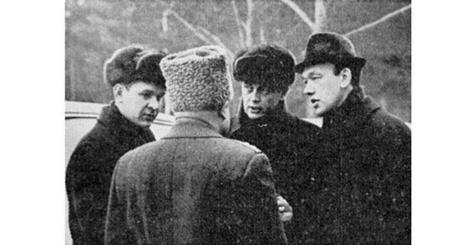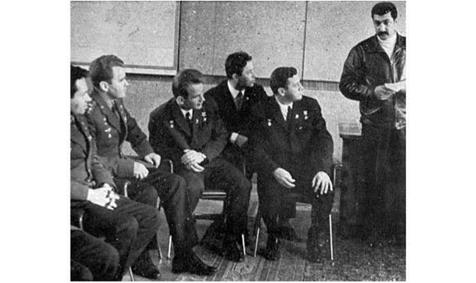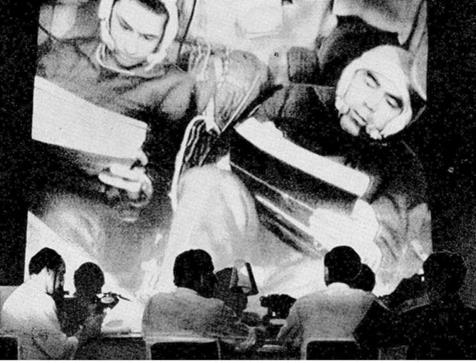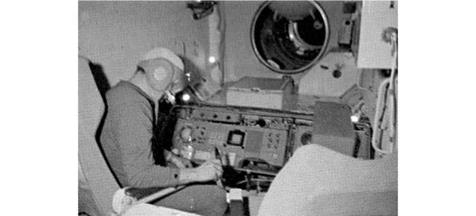REVISED APPOINTMENTS
On 6 May 1970 revised crews were nominated. They were:
• Crew 1: Georgiy Shonin, Aleksey Yeliseyev and Nikolay Rukavishnikov
• Crew 2: Aleksey Leonov, Valeriy Kubasov and Pyotr Kolodin
• Crew 3: Vladimir Shatalov, Vladislav Volkov and Viktor Patsayev
• Crew 4: Georgiy Dobrovolskiy, Vitaliy Sevastyanov and Anatoliy Voronov
By this point, relations between Mishin and Kamanin were improving. Mishin had accepted most of Kamanin’s criticisms. Splitting Shatalov from Yeliseyev led to Shatalov having an unpleasant conversation with Kamanin at being demoted from commanding the first crew to visit the space station. Mishin and Kamanin agreed a more equitable share of the nominations: with the first and third crews having one TsPK cosmonaut (who was commander) and two TsKBEM cosmonaut-engineers; and with the second and fourth crews having two military cosmonauts and one civilian. In return, Kamanin allowed his cosmonauts to visit Kaliningrad to perform part of their training with their civilian counterparts – thereby relieving the demand on the TsPK’s simulators. Since the L1 and L3 lunar programmes were both stalled, Kamanin reassigned all the military cosmonauts nominally in training for such missions to other projects, including DOS.
In the reshuffle Shatalov was moved from the first crew to replace Volynov on the third, with Shonin taking Shatalov’s place. Kamanin nominated Colonel Leonov, another veteran from the first group of cosmonauts who had trained to command the first L1 circumlunar mission, to fill Shonin’s place. Khrunov was replaced as commander of the fourth crew by Lieutenant-Colonel Dobrovolskiy who, although he had been recruited in 1963 as a member of the second Air Force group, had not yet flown in space. Mishin replaced Feoktistov by advancing Volkov from the fourth crew, then reassigned Sevastyanov’s role from research engineer to flight engineer. Kamanin completed this crew with Lieutenant-Colonel Voronov, who was another member of the Air Force’s second group who had yet to fly. All the research engineers were rookies, and the first three crews each had two experienced cosmonauts – one from each community. The inexperience of Dobrovolskiy’s crew was not considered to be a problem, because they would have the longest time to
|
|
Kubasov (left), Volkov and Yeliseyev, flight engineers assigned to the first DOS station, in conversation with an Air Force representative (back to camera).
|
|
A rare photo showing some of the original DOS crewmembers at an early stage of training listening to a presentation at the TsKBEM: Shonin (left), Shatalov, Kubasov, an unidentified person and Volkov.
train and would be able to benefit from the lessons learned by their predecessors in operating a space station. On 13 May 1970 Mishin and Kamanin signed a decree which confirmed the crew assignments.
The names of all the cosmonauts have been mentioned intentionally, even those who were not actually able to train for a mission to the DOS-1 station, as this shows how the destinies of these men were influenced by incidents such as Khrunov’s car crash, Volynov’s Jewish blood, Kamanin’s dislike for Feoktistov, and the need to agree a fair balance of assignments between the two communities of cosmonauts.
In late July the Military-Industrial Commission (VPK) met specifically to discuss the progress with the DOS programme. Okhapkin, Mishin’s First Deputy, gave the TsKBEM report. In accordance with the original plan, two identical stations were to be built. DOS-1 was to be launched in early 1971 and be visited by two crews who would undertake a variety of scientific experiments and make terrestrial, solar and astronomical observations. Two further crews would visit DOS-2 in 1972. However, Okhapkin reported that as a result of a number of problems the project was about 2 months late. After Soyuz 8 experienced difficulties with its fgla rendezvous system on the ‘group flight’ in 1969, the design had been revised and the system transferred from the descent module to the orbital module in order to improve its ‘field of view’. In addition, since the flight to the station would take only one day and the capsule would return to Earth within hours of departing from the station, the designers had simplified its life support system; but there were delays in testing the revisions. The major change to the Soyuz was the inclusion of a docking system incorporating a 0.8-metre-diameter hatch to enable the cosmonauts to access the station. There had been delays in constructing this new system. Nevertheless, as soon as the schedule allowed, DOS-1 would be launched by one of Chelomey’s Proton rockets. After 8 to 10 days, the Soyuz 10 mission would be launched using the first 7K-T crew ferry. If everything went to plan, Shonin, Yeliseyev and Rukavishnikov would spend 30 days
|
A theory lecture in the early stage of DOS training, showing Shatalov and Patsayev (foreground), and Yeliseyev and Rukavishnikov. |
on the station. Twenty-five days after Soyuz 10’s return, Soyuz 11 would be launched with Leonov, Kubasov and Kolodin, who would spend up to 45 days in space, with the actual duration being determined by how well the flight progressed. ft was therefore hoped that the DOS-1 station would be able to be occupied for 75 days of its expected service life of 80-90 days. However, it was accepted that this would be a pioneering venture. The longest time that American astronauts had spent in space was 14 days, on a Gemini flight in December 1965. Several weeks prior to the VPK meeting, the 18-day flight of Soyuz 9 by cosmonauts Andriyan Nikolayev and Vitaliy Sevastyanov had broken this endurance record. As the days passed, the cosmonauts had become so tired that mission control had used a siren to wake them up. On their return to Earth their heart rates were twice the norm, and for three days neither man had been able to walk. ft took them a month to recover fully. fn fact, Nikolayev had to retire several months later owing to ongoing heart issues. fn view of the experiences of this crew, Kamanin said that missions of 30 or 45 days were unrealistic until more information was gained on how the human body was affected by prolonged exposure to weightlessness, and he argued that the early DOS flights should not exceed 20 days.
The VPK meeting ended without specifying the length of the missions for the DOS-1 station. Leonid Smirnov, the chairman of the commission, ordered that all testing must be done by the end of the year, and that the station must be launched in time to be celebrated by the 24th Congress of the Soviet Communist Party in March 1971.
fn June 1970 the engineers of the first and third crews (Yeliseyev, Rukavishnikov, Volkov and Patsayev) started to train at the TsPK, and began to pay regular visits to the Khrunichev factory in Fili to monitor the building the first station.
Yeliseyev recalls: “The construction of the station was rapid. ft took only a few days to build a wooden mockup – all its sections and elements were in accordance with the design, but instead of real devices and apparatus it had wooden models. With Rukavishnikov, f went to see the mockup of the first station. Compared to the Soyuz, it looked like a giant – it was more than 10 metres from one end to the other. There was room for several people to work, without hindrances. … Engineers were working continuously, checking every detail of the documentation. Every revision was tested on the mockup, with a detailed inspection. ff the change was acceptable, then it was made to the station. We were involved in testing the positioning of the controls, instrument panels and the apparatus for visual monitoring. We were also consulted on how the crew should work and rest. . . . This work was very interesting. However, f must admit that the most impressive thing was to watch the real station be born. … f had a feeling of being present at the nativity of a secret miracle that the public knew nothing about. However, the whole world would hear about it very soon.’’
The commanders of the first and the third crews (Shonin and Shatalov) joined in the training on 17 August. The second crew (Leonov, Kubasov and Kolodin) began to train on 18 September. The members of the fourth crew were each busy with his individual tasks. Dobrovolskiy’s assignment was to the Contact project, testing the rendezvous and docking techniques for the N1-L3 lunar programme, and he did not
|
|
Cosmonauts Sevastyanov (left) and Nikolayev shown on TV from Soyuz 9 during a communication session of their record-breaking mission in 1970.
|
|
Photos of cosmonauts training in the DOS-1 simulator are extremely rare. Here, an unidentified cosmonaut is in the commander’s seat, facing the main control panel.
begin DOS training until January 1971, after the cancellation of the N1-L3. After his Soyuz 9 mission Sevastyanov spent several months recuperating, and so did not start DOS training until October 1970. However, as was usual for cosmonauts who had just made their first flight, he was frequently sent on goodwill visits, both to the member republics of the USSR and to foreign countries. The third crewmember, Voronov, was also initially involved in another project. As a result, the fourth crew did not begin serious training for DOS until January 1971, and expected to have at least 18 months before making their flight.















